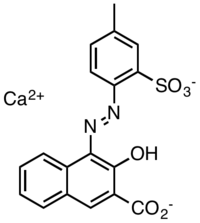Lithol Rubine BK
 | |
| Names | |
|---|---|
| IUPAC name
Calcium (4Z)-4-[(4-methyl-2-sulfonatophenyl)hydrazono]-3-oxo-2-naphthalenecarboxylate | |
| Other names
Pigment Rubine, Carmine 6B, Brilliant Carmine 6B, Permanent Rubin L6B, Litholrubine, Latolrubine, C.I. Pigment Red 57, C.I. Pigment Red 57:1, D&C Red No. 7, or C.I. 15850:1; E180 | |
| Identifiers | |
| 5281-04-9 | |
| ChemSpider | 17215383 |
| |
| Jmol-3D images | Image |
| PubChem | 9571018 |
| |
| UNII | ECW0LZ41X8 |
| Properties | |
| C18H12CaN2O6S | |
| Molar mass | 424.44 g/mol |
| Appearance | Red powder |
| slightly soluble in hot water, insoluble in cold water and ethanol | |
| Except where noted otherwise, data is given for materials in their standard state (at 25 °C (77 °F), 100 kPa) | |
| | |
| Infobox references | |
Lithol Rubine BK is a reddish synthetic azo dye. It has the appearance of a red powder and magenta when printed. It is slightly soluble in hot water, insoluble in cold water, and insoluble in ethanol. When dissolved in dimethylformamide, its absorption maximum lies at about 442 nm. It is usually supplied as a calcium salt.[1]
It is used to dye plastics, paints, printing inks, and for textile printing. It is normally used as a standard magenta in the three and four color printing processes.
When used as a food dye, it has E number E180. It is used to color cheese rind as well as a component in some lip balms. It is banned in some countries.
References
- ↑ K. Hunger. W. Herbst "Pigments, Organic" in Ullmann's Encyclopedia of Industrial Chemistry, Wiley-VCH, Weinheim, 2012. doi:10.1002/14356007.a20_371